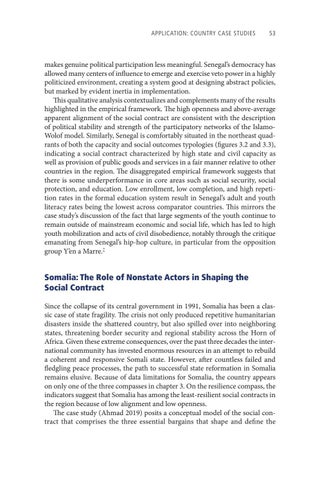Application: Country Case Studies 53
makes genuine political participation less meaningful. Senegal’s democracy has allowed many centers of influence to emerge and exercise veto power in a highly politicized environment, creating a system good at designing abstract policies, but marked by evident inertia in implementation. This qualitative analysis contextualizes and complements many of the results highlighted in the empirical framework. The high openness and above-average apparent alignment of the social contract are consistent with the description of political stability and strength of the participatory networks of the IslamoWolof model. Similarly, Senegal is comfortably situated in the northeast quadrants of both the capacity and social outcomes typologies (figures 3.2 and 3.3), indicating a social contract characterized by high state and civil capacity as well as provision of public goods and services in a fair manner relative to other countries in the region. The disaggregated empirical framework suggests that there is some underperformance in core areas such as social security, social protection, and education. Low enrollment, low completion, and high repetition rates in the formal education system result in Senegal’s adult and youth literacy rates being the lowest across comparator countries. This mirrors the case study’s discussion of the fact that large segments of the youth continue to remain outside of mainstream economic and social life, which has led to high youth mobilization and acts of civil disobedience, notably through the critique emanating from Senegal’s hip-hop culture, in particular from the opposition group Y’en a Marre.7
Somalia: The Role of Nonstate Actors in Shaping the Social Contract Since the collapse of its central government in 1991, Somalia has been a classic case of state fragility. The crisis not only produced repetitive humanitarian disasters inside the shattered country, but also spilled over into neighboring states, threatening border security and regional stability across the Horn of Africa. Given these extreme consequences, over the past three decades the international community has invested enormous resources in an attempt to rebuild a coherent and responsive Somali state. However, after countless failed and fledgling peace processes, the path to successful state reformation in Somalia remains elusive. Because of data limitations for Somalia, the country appears on only one of the three compasses in chapter 3. On the resilience compass, the indicators suggest that Somalia has among the least-resilient social contracts in the region because of low alignment and low openness. The case study (Ahmad 2019) posits a conceptual model of the social contract that comprises the three essential bargains that shape and define the

